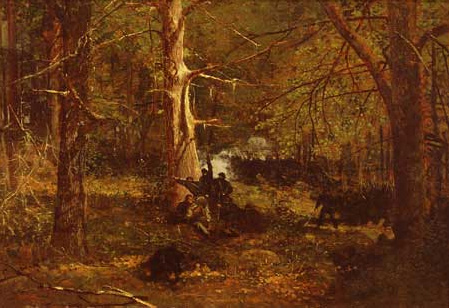Scene & Title Reunited: Homer's Interest in Battle Scenes

Homer's Interest in Battle Scenes
Early in his career, Homer occasionally allowed art reporters into his studio. In the New York Evening Post, February 21, 1866 in an article titled “About New York Painters: Works Now on Their Easels,” reported the following; Opposite to Mr. Hennessey is the studio of Winslow Homer—the walls covered with drawings of soldiers and girls, and battles, and episodes of the camp and march (2.7). That Homer was interested in the Civil War is clearly understood through his many paintings and drawings from the war years 1861-1865 and beyond. Homer traveled to the war front on three or more occasions. Even so, until now it was believed by many Homer faithful that only one known Homer art work actually depicted active battle.
Skirmish in the Wilderness, 1864, (Fig. 2-5) depicts a bloody event of war inside an over grown forest. Homer said the painting was based on sketches made at the scene (2.8). However, most Homer art historians believe there is ample historical documentation indicating that Homer was working on yet another battle scene.
Sally Mills reports her findings of other Homer experts who have strong suspicions that another battle painting was in the works; On the basis of several other studio sketches, showing cavalry soldiers or infantrymen in action, Lucretia Giese suggests that Homer may also have been considering a major battle painting in late 1863-1864. Painter of the Civil War (2.9). Lucretia Giese relates her finding of another important reason why she believes Homer would have been motivated to create another battle scene; The trauma of the war, the urging of critics throughout the war years to painters to use war imagery, and Homer’s striving for critical acclaim may have all contributed (2.10).
Abigail Gerdts in the official Homer raisonne (2005) describing a drawing from 1864 titled Soldier Taking Aim, 226-R (2.11), suggests that this drawing and others represent Homer’s interest in creating a second active battle scene; This is one of a surviving group of large-scaled studio drawing that imply Homer was working in the winter of 1864 toward a serious painting on the subject of active battle (2.12).Gerdts later on in the raisonne points out that, Homer field sketches of active battle also exist. However there are surviving field sketches representing soldiers actively involved in battle, which, although not inscribed, may be assigned to 1864 by style and subject details (2.13). Because there was no battle scene, other than Skirmish in the Wilderness, known at the time of publication in 2005, Gerdts goes on to speculate that this serious active battle scene was never realized by Homer (2.14). However, it would have been unusual for Homer to have abandoned a painting concept he had put so much preparation time personally observing (field sketches) as well as studied (studio drawings). Gerdts 1865 chronology reports; … Homer separated his summer into a period in which his emphasis was on touring and trolling for subject themes and images, and a later period in which he settled more on working up ideas toward the paintings he would complete in his New York studio (2.15). It was typical for Homer to have several paintings in process at anytime. It is accepted knowledge that if he was not satisfied with a painting he may leave the work hanging on his studio wall for years until he was again inspired to finish the image (2.16).
Watching the Shot. © 2024 All rights reserved. Terms of Use and Privacy Policy

